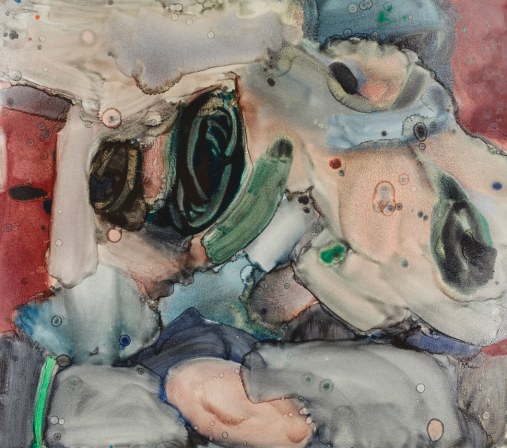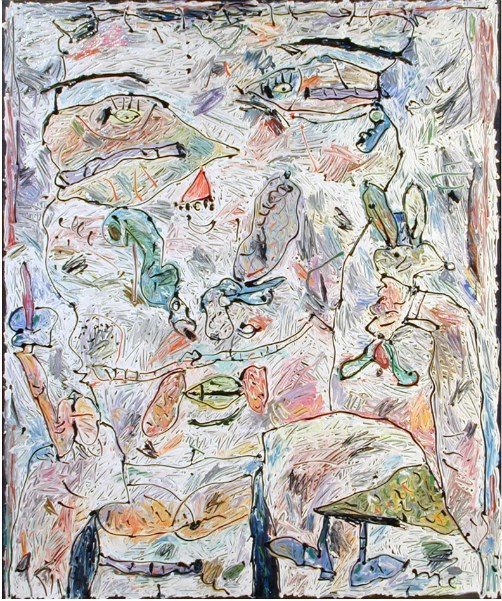From a 2008 profile I wrote in the PI, when there still was a real PI:
Growing up as a shy kid with an overprotective mother in the Skagit Valley, Alden Mason studied bugs, watched birds become blurs in the sky and fish leap in the river.
He was no good at sports because he couldn’t see the ball, and no good at math because he couldn’t see the blackboard. But on winter mornings he liked to stand close to cows whose breath made fat, white bursts in the air.
To escape the strictures of home, he wandered into fields to smudge furrowed lines with his toe.Mason, 88, has led an urban life without acquiring an urban viewpoint. His work is full of the things that moved him as a child, including the sparrows that flew around his head as he offered them carrots.
While realizing that his art owes a lot to his early encounters with nature, he also credits a mail-order cartoon class. He earned the tuition by trapping muskrats.
“I feel guilty about those muskrats,” he said, “but I loved cartoons, with figures jumping, hopping and smooching. They were having more fun than I was. They lived in a brighter world.”
At long last, Alden Mason is soloing at the Seattle Art Museum. SAM’s assistant curator of modern and contemporary art, Marisa C. Sánchez,
brought the exhibit to fruition after the departure of Michael Darling,
who chose the 13 paintings from the museum’s considerable Mason
holdings and solicited an addition to fill a gap.
Mason exhibits tend to be crowded, operating on the artist’s own
principle that if a little is good, more is better. This one feels open,
light and full of air. More radically, it ranges across the artist’s
multiple styles, from 1947 to 1986, and manages to find a thread. In
this show, his restlessness reads like a virtue.
It opens with his punched-up tributes to landscape painter Ray Hill
in the late 1940s and his super-flat Pop abstractions in the 1960s,
moves to his Burpee Garden series in the 1970s, and concludes with
squiggle and scratch paintings in the 1980s.
Named for the seed catalog, Burpee Garden paintings remain Mason’s
greatest success — although fumes from the oil paint, varnish and
turpentine that gave the series its high-toned wet look nearly killed
him and forced a move to acrylics.
From Burpee Garden, Inside Out Landscape oil/canvas 1972 oil/canvas 70 x 80 inches
 Burpee Garden paintings are abstractions, his contribution to a version of post-Abstract Expressionism pioneered by Helen Frankenthaler and Morris Louis. What Mason has achieved in his paintings since then is to use a similar style of abstraction as a ground for the Dubuffet-derived figures who always populated his drawings.
Burpee Garden paintings are abstractions, his contribution to a version of post-Abstract Expressionism pioneered by Helen Frankenthaler and Morris Louis. What Mason has achieved in his paintings since then is to use a similar style of abstraction as a ground for the Dubuffet-derived figures who always populated his drawings.
Fun-loving and upbeat, Mason also is restless. When he abandoned Burpee as the series was catching on around the country, his health was the reason, but he wouldn’t have stuck with it anyway. Others were enthralled, but he was getting bored. He bores quickly, changing galleries and wives, losing houses in divorces.
Even though most of his figures were born old, warped in time and oppressed by place, they kick up their misshaped legs to dance. Those without legs wave useless arms. Those missing both arms and legs rock in place, fat heads tottering on long necks.
Mason’s work remains improvisational and celebratory. Even when his figures signal a tragedy, the universe hums around them.
Billy 1986 acrylic/canvas 61 x 51 inches
 Through Oct. 16, 2011, third floor.
Through Oct. 16, 2011, third floor.



Alden is one of the first painters I encountered after High School that I was inspired by, so excited about this show!